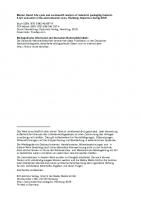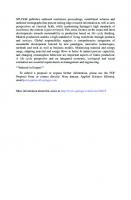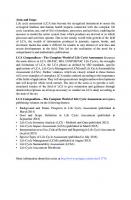Engineering Economics of Life Cycle Cost Analysis [2 ed.] 1032184868, 9781032184869
The rise of the information age and the digital economy has dramatically changed engineering and other technology-driven
294 13 17MB
English Pages 411 [412] Year 2023
Table of contents :
Cover
Half Title
Title Page
Copyright Page
Contents
List of Abbreviations
Preface
Acknowledgments
About the Authors
SECTION 1: The Mathematics of Engineering Economy
Chapter 1: Overview of Systems Life Cycle Costing
1.1. Overview of Engineering Economic Analysis
1.1.1. Business Operations
1.1.2. Customer Relationships
1.1.3. Engineering Services
1.1.4. Product and Process Realization
1.2. Engineering Challenges for the 21st Century
1.3. Introduction to Systems Life Cycle Costing
1.3.1. Systems Life Cycle Costing
1.4. Cost Analysis, Estimation, and Management
1.4.1. Cost Analysis
1.4.2. Cost Estimation
1.4.2.1. Parametric Cost Estimation
1.4.2.2. Analogy Cost Estimating Methodology
1.4.2.3. Engineering Build-Up Methodology
1.4.3. Cost Management
1.5. Summary
References
Chapter 2: The Science of Engineering Economics: Understanding the Time Value of Money
2.1. Introduction and the Time Value of Money
2.2. The Capital Budgeting Decision
2.2.1. Basic Concepts in Capital Budgeting
2.2.2. Benefit and Cost Development
2.3. Time Value of Money
2.3.1. Cash Flow Diagram Rules
2.4. Interest
2.4.1. Simple Interest
2.4.2. Compounded Interest
2.4.3. The “Rule of 72”
2.4.4. Compound Interest Notation and Interest Tables
2.4.5. Interest Compounded Other Than Yearly
2.5. Common Cash Flow Series
2.5.1. Single Period Cash Flow
2.5.2. Uniform Cash Flow Series
2.5.3. Linear Gradient Cash Flow Series
2.5.4. Irregular Cash Flow Series
2.6. Concept of Economic Equivalence
2.7. Amortization Schedules
2.8. Summary
Bibliography
References
Chapter 3: Advanced Economic Analysis of Alternatives
3.1. Introduction
3.2. Net Present Value
3.2.1. NPV in Excel
3.3. Annual Equivalent Worth
3.3.1. Introduction
3.3.2. Unequal Service Lives Using AEW
3.4. Capital Budgeting: Selection of Multiple Projects
3.5. After-Tax Cash Flow Analysis
3.5.1. Depreciation
3.5.2. Corporate Income Taxes
3.6. Income and Cash Flow Statements
3.7. Summary
Bibliography
References
Chapter 4: The Basic Theory of Interest
4.1. Introduction
4.2. Interest as Time Value of Money
4.3. Inflation
4.3.1. Determining Inflation and Deflation
4.4. Disinflation, Deflation, and Stagflation
4.5. Market Interest Rates
4.5.1. United States Treasury Debt
4.5.2. Debt
4.5.3. Equity
4.5.4. Minimum Attractive Rate of Return
4.6. Summary
Bibliography
References
Chapter 5: Simulation-Based Costing
5.1. Introduction
5.1.1. Ways to Study a System
5.1.2. Advantages and Disadvantages of Simulations
5.2. Review of Probability and Statistics
5.2.1. Introduction
5.2.2. Random Variables
5.2.3. Probability Density Functions
5.2.4. Cumulative Distribution Functions
5.3. Discrete Process Generators
5.4. Continuous Process Generators
5.5. Probability and Statistics Summary
5.6. Simulation in Practice
5.6.1. Introduction to Simulation in Practice
5.6.2. Building Complex Simulations
5.7. Using Readiness Levels for Model Input
5.8. Simulation Using Spreadsheets
5.8.1. Introduction
5.9. Building Systems Simulations
5.9.1. Introduction
5.9.2. Using Expert Elicitation for Data Development
5.9.3. Adjusting for Bias
5.10. Sensitivity Analysis
5.11. Summary
References
SECTION 2: Cost Estimation of Complex Systems
Chapter 6: Life Cycle Framework and Techniques
6.1. Introduction to Developing Life Cycle Models
6.2. Developing LCC Models
6.3. Life Cycle Costs Categories
6.3.1. Industrial Base and Supplier/Vendor Relationships
6.3.2. Research, Development, Testing, and Evaluation
6.3.3. Acquisition
6.3.4. Operations and Support
6.3.5. Disposal or Retirement
6.3.6. Summary of Life Cycle Categories
6.4. Billable Rates
6.5. Costing Labor
6.6. Summary
Bibliography
References
Chapter 7: Costing of Complex Systems
7.1. Introduction
7.2. Issues Surrounding Complex Systems
7.3. Systems Engineering and Management Costs
7.3.1. Hardware
7.3.2. Software
7.3.3. Interfaces and Integration at the Component and System Level
7.3.4. Systems Engineering and Project Management Costs
7.4. From Requirements to Architectures to Costs
7.5. Summary
References
Chapter 8: Software-Intensive Systems
8.1. Introduction
8.2. Software Estimating Techniques
8.2.1. Overview
8.2.2. Expertise-Based and Hybrid Models
8.2.3. Algorithmic Models
8.2.3.1. Original or Basic COCOMO Model
8.2.3.2. Phase Distribution of Effort and Schedule for Organic Mode
8.2.3.3. Intermediate COCOMO
8.2.3.4. Advanced COCOMO
8.2.4. Function Points
8.2.5. Costing Software with Agile Development
8.3. Summary
Bibliography
References
Appendix 8.A Effort Multiplier for the Intermediate COCOMO Model (from Boehm et al., 2000) ...........221
Chapter 9: Cost Estimating Techniques
9.1. Estimating Life Cycle Costs Throughout the Product Development Cycle
9.2. Analogy
9.3. Parametric Cost Estimating
9.3.1. The Role of Statistics
9.3.2. Some CERs of Interest
9.3.2.1. Wright’s Method
9.3.3. Summary and Conclusions
9.4. Detailed Engineering Builds
9.5. Summary
References
Chapter 10: The Role of Risk, Value, and Cost in Making Decisions
10.1. Introduction
10.2. Common Decision Analysis Tools
10.2.1. Decision Trees
10.2.2. Decision-Making Based upon Value Analysis
10.2.3. Pugh Matrix
10.2.4. Summary
10.3. Risk
10.3.1. Overview
10.3.2. Risk Buffers
10.4. Integrating Risk, Value, and Costs for Decision Analysis
10.5. Making Defensible and Transparent Decisions
10.5.1. Bias
10.6. Summary
Bibliography
References
Chapter 11: Costing the Cloud, Data, and Machine Learning
11.1. Introduction
11.2. The Role of the Cloud
11.3. Costing Data
11.4. Cost Considerations for Artificial Intelligence and Machine Learning
11.5. Conclusion
Bibliography
References
SECTION 3: Cost Management
Chapter 12: Costing and Managing Off-the-Shelf Systems
12.1. Introduction
12.2. Commercial Off-the-Shelf Systems
12.2.1. Hardware-centric COTS
12.2.2. Software-centric COTS
12.2.3. Integration Costs
12.3. Gots
12.4. Software Reuse
12.4.1. Cost Reductions Achieved with Software Reuse
12.5. Open Source
12.6. Summary
Bibliography
References
Chapter 13: Project Management’s Role in Life Cycle Costing
13.1. Introduction
13.2. Basics of Networks
13.3. Work Breakdown Structure
13.4. Progress Measurement
13.5. Calculating Earned Value
13.6. Monte Carlo Simulation of Networks
13.7. Summary
Bibliography
References
Chapter 14: Use of Cost Metrics and Ratios
14.1. Introduction
14.2. Benefit-Cost Ratio
14.3. Return on Investment
14.4. Cost-Benefit Analysis
14.5. Expected Value
14.6. Sensitivity Analysis
14.7. Breakeven Analysis
14.7.1. Breakeven Quantity
14.7.2. Conventional Payback Period
14.7.3. Discounted Payback Period
14.7.4. Breakeven Charts
14.8. Internal Rate of Return
14.8.1. The Compounding Equation
14.8.2. The Quadratic Equation
14.8.3. Trial-and-Error Method
14.8.4. IRR in Excel
14.8.5. Incremental IRR
14.9. Summary
References
Appendix A
Appendix B
Index
Cover
Half Title
Title Page
Copyright Page
Contents
List of Abbreviations
Preface
Acknowledgments
About the Authors
SECTION 1: The Mathematics of Engineering Economy
Chapter 1: Overview of Systems Life Cycle Costing
1.1. Overview of Engineering Economic Analysis
1.1.1. Business Operations
1.1.2. Customer Relationships
1.1.3. Engineering Services
1.1.4. Product and Process Realization
1.2. Engineering Challenges for the 21st Century
1.3. Introduction to Systems Life Cycle Costing
1.3.1. Systems Life Cycle Costing
1.4. Cost Analysis, Estimation, and Management
1.4.1. Cost Analysis
1.4.2. Cost Estimation
1.4.2.1. Parametric Cost Estimation
1.4.2.2. Analogy Cost Estimating Methodology
1.4.2.3. Engineering Build-Up Methodology
1.4.3. Cost Management
1.5. Summary
References
Chapter 2: The Science of Engineering Economics: Understanding the Time Value of Money
2.1. Introduction and the Time Value of Money
2.2. The Capital Budgeting Decision
2.2.1. Basic Concepts in Capital Budgeting
2.2.2. Benefit and Cost Development
2.3. Time Value of Money
2.3.1. Cash Flow Diagram Rules
2.4. Interest
2.4.1. Simple Interest
2.4.2. Compounded Interest
2.4.3. The “Rule of 72”
2.4.4. Compound Interest Notation and Interest Tables
2.4.5. Interest Compounded Other Than Yearly
2.5. Common Cash Flow Series
2.5.1. Single Period Cash Flow
2.5.2. Uniform Cash Flow Series
2.5.3. Linear Gradient Cash Flow Series
2.5.4. Irregular Cash Flow Series
2.6. Concept of Economic Equivalence
2.7. Amortization Schedules
2.8. Summary
Bibliography
References
Chapter 3: Advanced Economic Analysis of Alternatives
3.1. Introduction
3.2. Net Present Value
3.2.1. NPV in Excel
3.3. Annual Equivalent Worth
3.3.1. Introduction
3.3.2. Unequal Service Lives Using AEW
3.4. Capital Budgeting: Selection of Multiple Projects
3.5. After-Tax Cash Flow Analysis
3.5.1. Depreciation
3.5.2. Corporate Income Taxes
3.6. Income and Cash Flow Statements
3.7. Summary
Bibliography
References
Chapter 4: The Basic Theory of Interest
4.1. Introduction
4.2. Interest as Time Value of Money
4.3. Inflation
4.3.1. Determining Inflation and Deflation
4.4. Disinflation, Deflation, and Stagflation
4.5. Market Interest Rates
4.5.1. United States Treasury Debt
4.5.2. Debt
4.5.3. Equity
4.5.4. Minimum Attractive Rate of Return
4.6. Summary
Bibliography
References
Chapter 5: Simulation-Based Costing
5.1. Introduction
5.1.1. Ways to Study a System
5.1.2. Advantages and Disadvantages of Simulations
5.2. Review of Probability and Statistics
5.2.1. Introduction
5.2.2. Random Variables
5.2.3. Probability Density Functions
5.2.4. Cumulative Distribution Functions
5.3. Discrete Process Generators
5.4. Continuous Process Generators
5.5. Probability and Statistics Summary
5.6. Simulation in Practice
5.6.1. Introduction to Simulation in Practice
5.6.2. Building Complex Simulations
5.7. Using Readiness Levels for Model Input
5.8. Simulation Using Spreadsheets
5.8.1. Introduction
5.9. Building Systems Simulations
5.9.1. Introduction
5.9.2. Using Expert Elicitation for Data Development
5.9.3. Adjusting for Bias
5.10. Sensitivity Analysis
5.11. Summary
References
SECTION 2: Cost Estimation of Complex Systems
Chapter 6: Life Cycle Framework and Techniques
6.1. Introduction to Developing Life Cycle Models
6.2. Developing LCC Models
6.3. Life Cycle Costs Categories
6.3.1. Industrial Base and Supplier/Vendor Relationships
6.3.2. Research, Development, Testing, and Evaluation
6.3.3. Acquisition
6.3.4. Operations and Support
6.3.5. Disposal or Retirement
6.3.6. Summary of Life Cycle Categories
6.4. Billable Rates
6.5. Costing Labor
6.6. Summary
Bibliography
References
Chapter 7: Costing of Complex Systems
7.1. Introduction
7.2. Issues Surrounding Complex Systems
7.3. Systems Engineering and Management Costs
7.3.1. Hardware
7.3.2. Software
7.3.3. Interfaces and Integration at the Component and System Level
7.3.4. Systems Engineering and Project Management Costs
7.4. From Requirements to Architectures to Costs
7.5. Summary
References
Chapter 8: Software-Intensive Systems
8.1. Introduction
8.2. Software Estimating Techniques
8.2.1. Overview
8.2.2. Expertise-Based and Hybrid Models
8.2.3. Algorithmic Models
8.2.3.1. Original or Basic COCOMO Model
8.2.3.2. Phase Distribution of Effort and Schedule for Organic Mode
8.2.3.3. Intermediate COCOMO
8.2.3.4. Advanced COCOMO
8.2.4. Function Points
8.2.5. Costing Software with Agile Development
8.3. Summary
Bibliography
References
Appendix 8.A Effort Multiplier for the Intermediate COCOMO Model (from Boehm et al., 2000) ...........221
Chapter 9: Cost Estimating Techniques
9.1. Estimating Life Cycle Costs Throughout the Product Development Cycle
9.2. Analogy
9.3. Parametric Cost Estimating
9.3.1. The Role of Statistics
9.3.2. Some CERs of Interest
9.3.2.1. Wright’s Method
9.3.3. Summary and Conclusions
9.4. Detailed Engineering Builds
9.5. Summary
References
Chapter 10: The Role of Risk, Value, and Cost in Making Decisions
10.1. Introduction
10.2. Common Decision Analysis Tools
10.2.1. Decision Trees
10.2.2. Decision-Making Based upon Value Analysis
10.2.3. Pugh Matrix
10.2.4. Summary
10.3. Risk
10.3.1. Overview
10.3.2. Risk Buffers
10.4. Integrating Risk, Value, and Costs for Decision Analysis
10.5. Making Defensible and Transparent Decisions
10.5.1. Bias
10.6. Summary
Bibliography
References
Chapter 11: Costing the Cloud, Data, and Machine Learning
11.1. Introduction
11.2. The Role of the Cloud
11.3. Costing Data
11.4. Cost Considerations for Artificial Intelligence and Machine Learning
11.5. Conclusion
Bibliography
References
SECTION 3: Cost Management
Chapter 12: Costing and Managing Off-the-Shelf Systems
12.1. Introduction
12.2. Commercial Off-the-Shelf Systems
12.2.1. Hardware-centric COTS
12.2.2. Software-centric COTS
12.2.3. Integration Costs
12.3. Gots
12.4. Software Reuse
12.4.1. Cost Reductions Achieved with Software Reuse
12.5. Open Source
12.6. Summary
Bibliography
References
Chapter 13: Project Management’s Role in Life Cycle Costing
13.1. Introduction
13.2. Basics of Networks
13.3. Work Breakdown Structure
13.4. Progress Measurement
13.5. Calculating Earned Value
13.6. Monte Carlo Simulation of Networks
13.7. Summary
Bibliography
References
Chapter 14: Use of Cost Metrics and Ratios
14.1. Introduction
14.2. Benefit-Cost Ratio
14.3. Return on Investment
14.4. Cost-Benefit Analysis
14.5. Expected Value
14.6. Sensitivity Analysis
14.7. Breakeven Analysis
14.7.1. Breakeven Quantity
14.7.2. Conventional Payback Period
14.7.3. Discounted Payback Period
14.7.4. Breakeven Charts
14.8. Internal Rate of Return
14.8.1. The Compounding Equation
14.8.2. The Quadratic Equation
14.8.3. Trial-and-Error Method
14.8.4. IRR in Excel
14.8.5. Incremental IRR
14.9. Summary
References
Appendix A
Appendix B
Index
Recommend Papers
File loading please wait...
Citation preview
�"!
. . 'ti �










![Engineering Economics of Life Cycle Cost Analysis [2 ed.]
1032184868, 9781032184869](https://ebin.pub/img/200x200/engineering-economics-of-life-cycle-cost-analysis-2nbsped-1032184868-9781032184869.jpg)